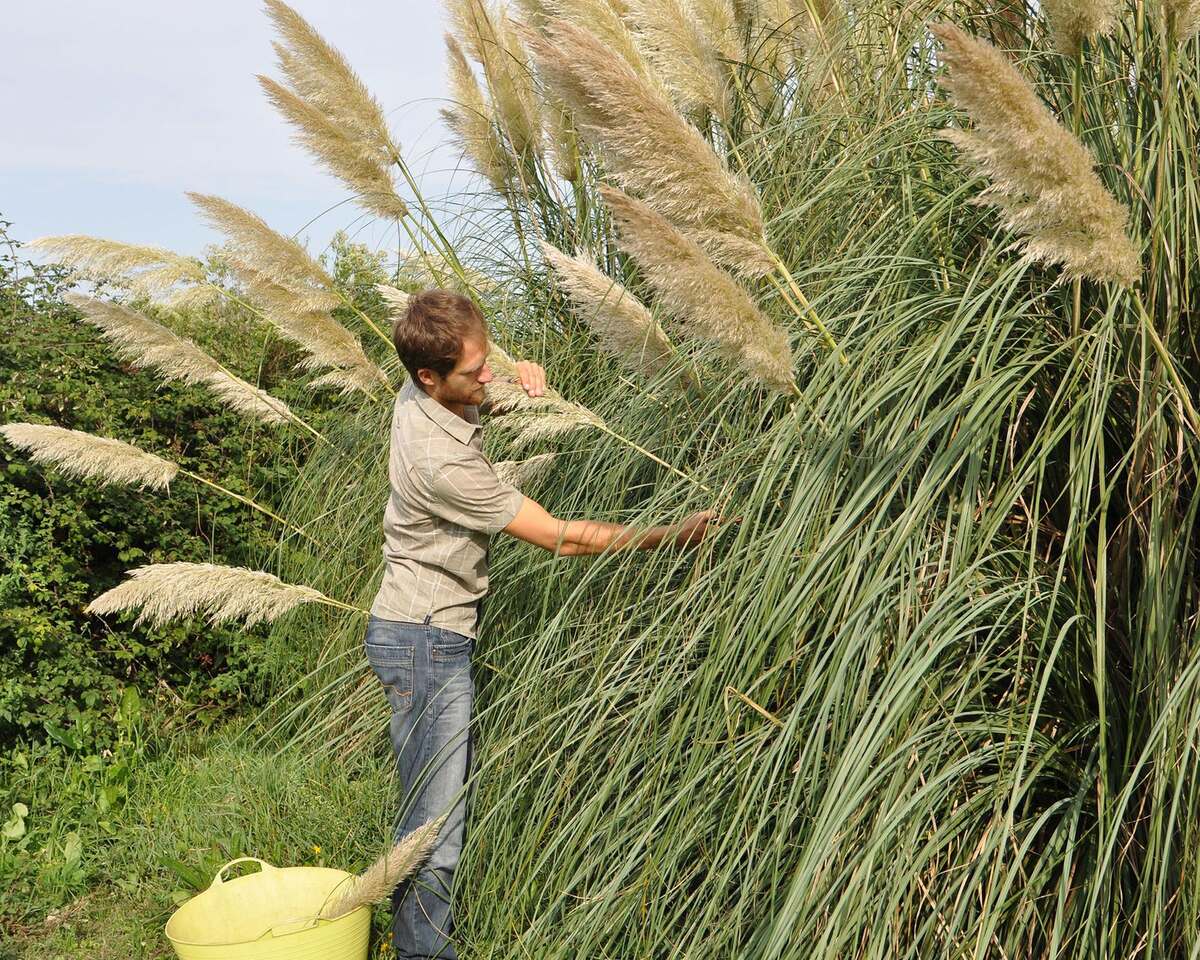Home>Gardening & Outdoor>Landscaping Ideas>What Are Grass Roots


Landscaping Ideas
What Are Grass Roots
Modified: February 18, 2024
Discover the basics of grass roots and their role in landscaping ideas. Learn how to nurture healthy grass roots for a thriving outdoor space. Explore more here!
(Many of the links in this article redirect to a specific reviewed product. Your purchase of these products through affiliate links helps to generate commission for Storables.com, at no extra cost. Learn more)
Introduction
Welcome to the world of landscaping, where the beauty of nature meets the creativity of human design. Landscaping is the art of transforming outdoor spaces into aesthetically pleasing and functional areas, and one of the fundamental elements in this art form is grass. Grass not only provides a lush green carpet for the landscape but also plays a crucial role in soil erosion control, air purification, and creating a serene ambiance.
In the realm of landscaping, the concept of grass roots holds a significant place. Understanding the essence of grass roots is essential for anyone passionate about landscaping or simply looking to enhance their outdoor spaces. In this article, we will delve into the meaning, history, characteristics, and impact of grass roots movements, shedding light on their relevance in the landscaping world.
Key Takeaways:
- Grass roots movements in landscaping emphasize community involvement, sustainable practices, and native plant use to create beautiful, eco-friendly outdoor spaces that celebrate nature’s beauty and support local ecosystems.
- By engaging local communities, grass roots movements empower individuals to become stewards of their outdoor environments, fostering a sense of pride, environmental responsibility, and social connection while promoting sustainable living.
Read more: What Type Of Root System Does The Grass Have
Definition of Grass Roots
Grass roots, in the context of landscaping and environmental movements, refers to the fundamental level of activity or support within a society or organization. The term originated from the world of botany, where the “roots” of a plant are its foundational and anchoring component. Similarly, in social and political contexts, grass roots represent the core and essential level of involvement or support for a cause, idea, or movement.
When applied to landscaping, the concept of grass roots embodies the fundamental principles and practices of sustainable and environmentally conscious outdoor design. It emphasizes the importance of organic and natural approaches to landscaping, including the use of native plants, eco-friendly materials, and water-efficient techniques. At its core, grass roots landscaping aims to create harmonious outdoor spaces that coexist with and contribute positively to the surrounding environment.
Furthermore, the term “grass roots” extends beyond the physical aspects of landscaping to encompass the community-driven and participatory nature of environmental movements. It emphasizes the involvement and empowerment of local communities in shaping their outdoor environments, fostering a sense of ownership and responsibility towards the natural world.
In essence, the definition of grass roots in landscaping encapsulates a holistic and sustainable approach to outdoor design, rooted in the principles of environmental stewardship, community engagement, and the celebration of nature’s inherent beauty.
History of Grass Roots Movements
The concept of grass roots movements has a rich and diverse history, deeply intertwined with the evolution of environmental awareness and the desire for sustainable living. The origins of grass roots movements can be traced back to the early environmental and conservation efforts that emerged in response to industrialization and urbanization.
During the 19th and early 20th centuries, as industrial expansion led to widespread environmental degradation, individuals and communities began to advocate for the preservation of natural landscapes and the protection of wildlife. These early conservation movements laid the groundwork for the grass roots approach to environmental stewardship, emphasizing the importance of local action and community involvement.
One of the pivotal moments in the history of grass roots movements was the rise of the modern environmental movement in the mid-20th century. This era saw the emergence of influential environmental organizations and the popularization of ecological consciousness, leading to widespread public engagement in environmental causes. Grass roots movements played a significant role in this period, as local communities rallied together to address issues such as pollution, deforestation, and habitat destruction.
As the environmental movement continued to gain momentum, the grass roots approach became increasingly prominent, with communities taking proactive measures to protect and enhance their natural surroundings. This trend extended to the realm of landscaping, where individuals and organizations began to embrace sustainable and eco-friendly practices, laying the foundation for the modern grass roots landscaping movement.
Today, the history of grass roots movements serves as a testament to the power of collective action and community-driven initiatives in shaping a more sustainable and harmonious relationship with the environment. It reflects the enduring spirit of individuals coming together to effect positive change at the local level, ultimately contributing to a global movement towards a greener and more environmentally conscious future.
Characteristics of Grass Roots Movements
Grass roots movements in landscaping and environmental advocacy are distinguished by several key characteristics that define their approach and impact. These characteristics underscore the grassroots ethos of community-driven, sustainable, and inclusive initiatives that seek to foster positive change at the local level.
- Community Engagement: At the heart of grass roots movements is the active participation and engagement of local communities in shaping their outdoor environments. This involvement creates a sense of ownership and responsibility, fostering a deeper connection to the natural world.
- Sustainability and Conservation: Grass roots movements prioritize sustainable and conservation-oriented practices, emphasizing the preservation of natural resources, the use of eco-friendly materials, and the promotion of biodiversity in landscaping and outdoor design.
- Advocacy for Native Landscaping: A hallmark of grass roots landscaping is the promotion and utilization of native plants and indigenous landscaping practices, celebrating the unique flora and fauna of a region while supporting local ecosystems.
- Empowerment and Education: Grass roots movements seek to empower individuals and communities through education and awareness, equipping them with the knowledge and tools to make informed decisions about sustainable landscaping practices and environmental stewardship.
- Bottom-Up Approach: Unlike top-down initiatives, grass roots movements operate from the ground up, with local communities driving the agenda and implementing solutions that are tailored to their specific environmental and landscaping needs.
- Creative and Artistic Expression: Grass roots landscaping encourages creative and artistic expression in outdoor design, blending aesthetics with ecological principles to create visually stunning and environmentally conscious landscapes.
These characteristics collectively embody the essence of grass roots movements in landscaping, reflecting a commitment to environmental responsibility, community collaboration, and the celebration of nature’s beauty in outdoor spaces.
Grassroots movements are driven by ordinary people at a local level, aiming to create change or address issues. They often start small and grow through community involvement and support.
Examples of Grass Roots Movements
Grass roots movements in landscaping and environmental conservation manifest in a diverse array of initiatives and projects that showcase the power of community-driven action and sustainable design. These examples illustrate the ingenuity, passion, and impact of grass roots movements in shaping outdoor environments and fostering a deeper connection to nature.
- Community Garden Projects: Across urban and suburban areas, community garden initiatives exemplify grass roots landscaping, where local residents come together to cultivate shared green spaces, promote urban agriculture, and create vibrant hubs of biodiversity and community interaction.
- Native Plant Restoration Efforts: Grass roots movements often involve the restoration of natural habitats through the propagation and reintroduction of native plant species, preserving local ecosystems and enhancing the ecological resilience of landscapes.
- Urban Tree Planting Campaigns: Community-led tree planting programs focus on increasing urban tree canopy coverage, mitigating the urban heat island effect, and promoting sustainable urban forestry practices through collaborative, grass roots efforts.
- Sustainable Landscaping Workshops: Grass roots movements frequently organize educational workshops and events to promote sustainable landscaping practices, such as water-wise gardening, permaculture design, and the use of native plants in residential and public landscapes.
- Community-Led Park Revitalization: Grass roots movements play a vital role in revitalizing public parks and green spaces, engaging local volunteers and organizations in activities such as trail maintenance, habitat restoration, and the installation of eco-friendly amenities.
- Neighborhood Pollinator Habitat Projects: Grass roots initiatives focused on creating pollinator-friendly habitats in residential neighborhoods contribute to the conservation of bees, butterflies, and other vital pollinators, fostering a biodiverse and ecologically supportive urban environment.
These examples exemplify the breadth and impact of grass roots movements in landscaping and environmental advocacy, illustrating the transformative potential of community-driven initiatives in nurturing sustainable, biodiverse, and visually captivating outdoor spaces.
Read more: How To Make Grass Roots Grow Deeper
Impact of Grass Roots Movements
Grass roots movements in landscaping and environmental conservation have a profound and far-reaching impact on local communities, ecosystems, and the broader landscape design industry. Their influence extends beyond the physical transformation of outdoor spaces, encompassing social, ecological, and cultural dimensions that shape a more sustainable and harmonious relationship with the environment.
Environmental Stewardship and Biodiversity: Grass roots movements contribute to the preservation of biodiversity and the restoration of natural habitats, fostering resilient and ecologically vibrant landscapes that support native flora and fauna. By promoting the use of native plants and sustainable landscaping practices, these movements play a crucial role in enhancing the ecological integrity of outdoor environments.
Community Empowerment and Social Cohesion: Grass roots initiatives empower local communities to actively participate in the design, care, and conservation of their outdoor spaces, fostering a sense of ownership, pride, and environmental responsibility. This engagement strengthens social bonds, promotes environmental awareness, and creates shared spaces for community interaction and recreation.
Education and Awareness: Grass roots movements serve as educational platforms, equipping individuals with the knowledge and skills to make informed decisions about sustainable landscaping practices, water conservation, and ecological resilience. By raising awareness about the importance of environmentally conscious design, these movements inspire a culture of environmental stewardship and mindful outdoor living.
Innovation and Creativity in Design: Grass roots landscaping encourages innovative approaches to outdoor design, blending artistic expression with ecological principles to create visually stunning and functional landscapes. This emphasis on creativity and innovation fosters a culture of design excellence that celebrates the beauty of nature while promoting sustainable living.
Policy and Advocacy: Grass roots movements influence local and regional policies related to landscaping, urban planning, and environmental conservation, advocating for regulations and incentives that support sustainable design practices, native plant use, and the protection of green spaces within urban and suburban areas.
Collectively, the impact of grass roots movements transcends the boundaries of traditional landscaping, contributing to the emergence of more ecologically resilient, socially connected, and aesthetically inspiring outdoor environments that reflect a deep reverence for nature and a commitment to sustainable living.
Conclusion
In the realm of landscaping and environmental advocacy, the concept of grass roots movements embodies the spirit of community-driven, sustainable, and inclusive initiatives that seek to transform outdoor spaces and nurture a deeper connection to the natural world. From its historical roots in early conservation efforts to its contemporary impact on urban and suburban landscapes, grass roots movements have reshaped the landscape design industry and fostered a culture of environmental stewardship and community engagement.
Through the promotion of native plant use, sustainable landscaping practices, and the revitalization of green spaces, grass roots movements have demonstrated their capacity to create biodiverse, visually captivating, and ecologically resilient outdoor environments. These initiatives not only enhance the aesthetic appeal of landscapes but also contribute to the preservation of biodiversity, the mitigation of urban heat islands, and the promotion of sustainable urban forestry practices.
Moreover, grass roots movements serve as catalysts for community empowerment, social cohesion, and environmental education, empowering individuals to become active stewards of their outdoor environments and fostering a sense of environmental responsibility and pride. By engaging local communities in the design, care, and conservation of outdoor spaces, these movements create shared hubs of biodiversity, recreation, and ecological learning that enrich the fabric of neighborhoods and urban environments.
As we look to the future of landscaping and outdoor design, the ethos of grass roots movements will continue to inspire innovation, creativity, and sustainable living, shaping a landscape design industry that is deeply rooted in ecological integrity, community collaboration, and the celebration of nature’s inherent beauty. By embracing the principles of grass roots landscaping, we can cultivate outdoor spaces that not only reflect our connection to the natural world but also serve as living testaments to the transformative power of community-driven, sustainable design.
Ultimately, the legacy of grass roots movements in landscaping and environmental advocacy lies in their ability to nurture landscapes that are not only visually stunning but also ecologically vibrant, socially enriching, and deeply meaningful to the communities they serve.
Frequently Asked Questions about What Are Grass Roots
Was this page helpful?
At Storables.com, we guarantee accurate and reliable information. Our content, validated by Expert Board Contributors, is crafted following stringent Editorial Policies. We're committed to providing you with well-researched, expert-backed insights for all your informational needs.















0 thoughts on “What Are Grass Roots”